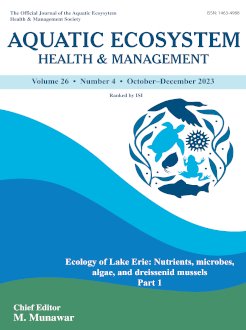This study reports directly measured nitrification rates in the water column of western Lake Erie, which is affected by annual cyanobacterial harmful algal blooms, and across all three Lake Erie basins. Over three field seasons, 15NH4 + stable isotope tracers were employed to quantify nitrification rates, and relative abundances of ammonia-oxidizing bacteria and ammonia-oxidizing archaea were determined via qPCR. Nitrification rates ranged from undetectable to 1,270 nmol L-1 d-1 and were generally greatest in the western basin near the Maumee River mouth (a major nutrient source). Nitrification rates were highest in early summer, and often lowest during peak cyanobacterial harmful algal blooms months (August and September), before increasing again in October. In the western basin, nitrification was negatively correlated with cyanobacterial biomass. There were no consistent differences in nitrification rates between the three Lake Erie basins. Over the three years in western Lake Erie, ammonia-oxidizing bacteria and ammonia-oxidizing archaea were often present in high and similar abundances, but overall, ammonia-oxidizing bacteria exceeded ammonia-oxidizing archaea, particularly in 2017. No relationships were observed between nitrification rates and ammonia-oxidizing bacteria and ammonia-oxidizing archaea abundances. Thus, despite abundant ammonia-oxidizer DNA, lower nitrification rates during cyanobacterial harmful algal blooms suggest that nitrifiers were poor competitors for regenerated and available NH4 + during these blooms, as also observed in similar systems. Low nitrification rates during cyanobacterial harmful algal blooms could limit system nitrogen removal via denitrification, a natural pathway for its removal and a valuable ecosystem service. Lower denitrification rates allow more bioavailable nitrogen to remain in the system and support biomass and microcystin production; therefore, these results help explain how non-nitrogen-fixing cyanobacterial harmful algal blooms persist, despite low bioavailable nitrogen concentrations during these blooms, and support management efforts to reduce external nitrogen loading to eutrophic systems.
How to translate text using browser tools
29 May 2024
Nitrification in the water column of Lake Erie: Seasonal patterns, community dynamics, and competition with cyanobacterial harmful algal blooms
D.K. Hoffman,
M.J. McCarthy,
A. Zastepa,
A.R. Boedecker,
J.A. Myers,
S.E. Newell
ACCESS THE FULL ARTICLE
cyanobacteria
Eutrophication
freshwater
nitrogen





